Bi-Level Optimal Capacity Planning of Load-Side Electric Energy Storage Using an Emission-Considered Carbon Incentive Mechanism
Abstract
:1. Introduction
- (1)
- Based on the carbon emission flow theory, this paper proposes a bi-level optimal capacity planning model for the load-side EES that considers the load-side carbon emission responsibility.
- (2)
- Focusing on carbon emissions of the power system, a carbon incentive mechanism of the load-side EES is proposed to promote the carbon-oriented EES configuration and operation.
- (3)
- Through case analysis, the effectiveness of the bi-level EES capacity planning model with the carbon incentive mechanism is verified. Furthermore, compared with the two existing EES subsidy policies, the proposed carbon incentive mechanism has relative superiority in terms of both economics and carbon reduction.
2. Carbon Incentive Mechanism Based on Carbon Emission Flow Theory
2.1. CEF in Power System Considering Grid Losses
2.2. Carbon Incentive Mechanism
- Based on the CEF theory, calculate the historical load-side carbon responsibilities according to historical power flow data and adopt the average value of the historical load-side carbon responsibilities as the baseline.
- Compare the historical load-side carbon responsibilities with the baseline and form a time-of-use carbon incentive price. If the historical load-side carbon responsibility is higher than the baseline, a high incentive price is adopted. If the historical carbon responsibility is lower than the baseline, a low incentive price is adopted.
- According to the incentive price, the carbon emission intensity of each load, and the actual discharge and charge electricity of the EES, the carbon incentive cost of each load can be obtained.
3. Bi-Level Optimal Capacity Planning Model of the EES
3.1. Model Overview
3.2. The Upper Level: Economic Dispatch Model
3.2.1. Optimization Objective
3.2.2. Constraints
3.3. The Lower Level: EES Capacity Planning Model
3.3.1. Optimization Objective
3.3.2. Constraints
4. Case Study
4.1. Test System and Initial Parameters
4.2. Optimization Results of EES Capacity Configuration
4.3. Comparison of the Proposed Mechanism with the Two Existing Policies
- Case 1: Bi-level optimal capacity planning of the load-side EES with the proposed carbon incentive mechanism;
- Case 2: Bi-level optimal capacity planning of the load-side EES with a discharge subsidy policy;
- Case 3: Bi-level optimal capacity planning of the load-side EES with a capacity subsidy policy.
5. Conclusions
Author Contributions
Funding
Institutional Review Board Statement
Informed Consent Statement
Data Availability Statement
Conflicts of Interest
References
- Meinshausen, M.; Lewis, J.; McGlade, C.; Gutschow, J.; Nicholls, Z.; Burdon, R.; Cozzi, L.; Hackmann, B. Realization of Paris Agreement pledges may limit warming just below 2 degrees C. Nature 2022, 604, 304–309. [Google Scholar] [CrossRef] [PubMed]
- Höhne, N.; Gidden, M.J.; den Elzen, M.; Hans, F.; Fyson, C.; Geiges, A.; Jeffery, M.L.; Gonzales-Zuñiga, S.; Mooldijk, S.; Hare, W.; et al. Wave of net zero emission targets opens window to meeting the Paris Agreement. Nat. Clim. Chang. 2021, 11, 820–822. [Google Scholar] [CrossRef]
- Zhou, S.; Tong, Q.; Pan, X.; Cao, M.; Wang, H.; Gao, J.; Ou, X. Research on low-carbon energy transformation of China necessary to achieve the Paris agreement goals: A global perspective. Energy Econ. 2021, 95, 105137. [Google Scholar] [CrossRef]
- Xiao, J.; Li, G.; Xie, L.; Wang, S.; Yu, L. Decarbonizing China’s power sector by 2030 with consideration of technological progress and cross-regional power transmission. Energy Policy 2021, 150, 112150. [Google Scholar] [CrossRef]
- Kang, J.-N.; Wei, Y.-M.; Liu, L.-C.; Han, R.; Yu, B.-Y.; Wang, J.-W. Energy systems for climate change mitigation: A systematic review. Appl. Energy 2020, 263, 114602. [Google Scholar] [CrossRef]
- Jurasz, J.; Canales, F.A.; Kies, A.; Guezgouz, M.; Beluco, A. A review on the complementarity of renewable energy sources: Concept, metrics, application and future research directions. Sol. Energy 2020, 195, 703–724. [Google Scholar] [CrossRef]
- Olabi, A.G.; Onumaegbu, C.; Wilberforce, T.; Ramadan, M.; Abdelkareem, M.A.; Al–Alami, A.H. Critical review of energy storage systems. Energy 2021, 214, 118987. [Google Scholar] [CrossRef]
- Koohi-Fayegh, S.; Rosen, M.A. A review of energy storage types, applications and recent developments. J. Energy Storage 2020, 27, 101047. [Google Scholar] [CrossRef]
- Basit, M.A.; Dilshad, S.; Badar, R.; Sami ur Rehman, S.M. Limitations, challenges, and solution approaches in grid-connected renewable energy systems. Int. J. Energy Res. 2020, 44, 4132–4162. [Google Scholar] [CrossRef]
- Sepulveda, N.A.; Jenkins, J.D.; Edington, A.; Mallapragada, D.S.; Lester, R.K. The design space for long-duration energy storage in decarbonized power systems. Nat. Energy 2021, 6, 506–516. [Google Scholar] [CrossRef]
- Groppi, D.; Pfeifer, A.; Garcia, D.A.; Krajačić, G.; Duić, N. A review on energy storage and demand side management solutions in smart energy islands. Renew. Sustain. Energy Rev. 2021, 135, 110183. [Google Scholar] [CrossRef]
- Rahman, M.M.; Oni, A.O.; Gemechu, E.; Kumar, A. Assessment of energy storage technologies: A review. Energy Convers. Manag. 2020, 223, 113295. [Google Scholar] [CrossRef]
- Shi, Z.; Wang, W.; Huang, Y.; Li, P.; Dong, L. Simultaneous Optimization of Renewable Energy and Energy Storage Capacity with the Hierarchical Control. CSEE J. Power Energy Syst. 2022, 8, 95–104. [Google Scholar]
- Kumar, N.; Kumar, T.; Nema, S.; Thakur, T. A multiobjective planning framework for EV charging stations assisted by solar photovoltaic and battery energy storage system in coupled power and transportation network. Int. J. Energy Res. 2021, 46, 4462–4493. [Google Scholar] [CrossRef]
- Yi, T.; Cheng, X.; Chen, Y.; Liu, J. Joint optimization of charging station and energy storage economic capacity based on the effect of alternative energy storage of electric vehicle. Energy 2020, 208, 118357. [Google Scholar] [CrossRef]
- Karimi, A.; Aminifar, F.; Fereidunian, A.; Lesani, H. Energy storage allocation in wind integrated distribution networks: An MILP-Based approach. Renew. Energy 2019, 134, 1042–1055. [Google Scholar] [CrossRef]
- Akram, U.; Khalid, M.; Shafiq, S. Optimal sizing of a wind/solar/battery hybrid grid-connected microgrid system. IET Renew. Power Gener. 2017, 12, 72–80. [Google Scholar] [CrossRef]
- Dvorkin, Y.; Fernandez-Blanco, R.; Kirschen, D.S.; Pandzic, H.; Watson, J.-P.; Silva-Monroy, C.A. Ensuring Profitability of Energy Storage. IEEE Trans. Power Syst. 2017, 32, 611–623. [Google Scholar] [CrossRef]
- Gou, X.; Chen, Q.; Hu, K.; Ma, H.; Chen, L.; Wang, X.-H.; Qi, J.; Xu, F.; Min, Y. Optimal planning of capacities and distribution of electric heater and heat storage for reduction of wind power curtailment in power systems. Energy 2018, 160, 763–773. [Google Scholar] [CrossRef]
- Mansoor, M.; Stadler, M.; Zellinger, M.; Lichtenegger, K.; Auer, H.; Cosic, A. Optimal planning of thermal energy systems in a microgrid with seasonal storage and piecewise affine cost functions. Energy 2021, 215, 119095. [Google Scholar] [CrossRef]
- Li, K.; Wei, X.; Yan, Y.; Zhang, C. Bi-level optimization design strategy for compressed air energy storage of a combined cooling, heating, and power system. J. Energy Storage 2020, 31, 101642. [Google Scholar] [CrossRef]
- Xu, Y.; Lang, Y.; Wen, B.; Yang, X. An Innovative Planning Method for the Optimal Capacity Allocation of a Hybrid Wind–PV–Pumped Storage Power System. Energies 2019, 12, 2809. [Google Scholar] [CrossRef] [Green Version]
- Yan, Z.; Zhang, Y.; Liang, R.; Jin, W. An allocative method of hybrid electrical and thermal energy storage capacity for load shifting based on seasonal difference in district energy planning. Energy 2020, 207, 118139. [Google Scholar] [CrossRef]
- Hemmati, R.; Shafie-Khah, M.; Catalao, J.P.S. Three-Level Hybrid Energy Storage Planning Under Uncertainty. IEEE Trans. Ind. Electron. 2019, 66, 2174–2184. [Google Scholar] [CrossRef]
- Cheng, H.; Wu, J.; Luo, Z.; Zhou, F.; Liu, X.; Lu, T. Optimal Planning of Multi-Energy System Considering Thermal Storage Capacity of Heating Network and Heat Load. IEEE Access 2019, 7, 13364–13372. [Google Scholar] [CrossRef]
- Khalid, M.; Akram, U.; Shafiq, S. Optimal Planning of Multiple Distributed Generating Units and Storage in Active Distribution Networks. IEEE Access 2018, 6, 55234–55244. [Google Scholar] [CrossRef]
- Wang, Q.; Tan, Z.; De, G.; Pu, L.; Wu, J. Research on promotion incentive policy and mechanism simulation model of energy storage technology. Energy Sci. Eng. 2019, 7, 3147–3159. [Google Scholar] [CrossRef]
- Zhou, T.; Kang, C.; Xu, Q.; Chen, Q. Preliminary Theoretical Investigation on Power System Carbon Emission Flow. Autom. Electr. Power Syst. 2012, 36, 38–43. [Google Scholar]
- Kang, C.; Zhou, T.; Chen, Q.; Wang, J.; Sun, Y.; Xia, Q.; Yan, H. Carbon Emission Flow from Generation to Demand: A Network-Based Model. IEEE Trans. Smart Grid 2015, 6, 2386–2394. [Google Scholar] [CrossRef]
- Chen, D. Study on Factor Decomposition and Network Flow Analysis of Carbon Emission in Power System; Zhejiang University: Hangzhou, China, 2016. [Google Scholar]
- Sivanagaraju, S.; Satyanarayana, S. Electric Power Transmission and Distribution Losses; Pearson Education: Delhi, India, 2018. [Google Scholar]
- Bialek, J. Tracing the Flow of Electricity. IEE Proc. Gener. Transm. Distrib. 1996, 143, 313–320. [Google Scholar] [CrossRef] [Green Version]
- Li, Y.; Zhang, N.; Du, E.; Liu, Y.; Cai, X.; He, D. Mechanism Study and Benefit Analysis on Power System Low Carbon Demand Response Based on Carbon Emission Flow. Proc. CSEE 2022, 42, 2830–2841. [Google Scholar]
- Yang, L.; Xu, Y.; Sun, H.; Zhao, X. Two-Stage Convexification-Based Optimal Electricity-Gas Flow. IEEE Trans. Smart Grid 2020, 11, 1465–1475. [Google Scholar] [CrossRef]
- Zimmerman, R.D.; Murillo-Sánchez, C.E. MATPOWER User’s Manual. 2021. Available online: https://matpower.org/docs/MATPOWER-manual.pdf (accessed on 19 May 2022).
- Jamie McIntyre, B.B.; Seto, H.; Borchard, S. Comparison of Lifecycle Greenhouse Gas Emissions of Various Electricity Generation Sources; World Nuclear Association: London, UK, 2011. [Google Scholar]
- Cheng, Y.; Zhang, N.; Zhang, B.; Kang, C.; Xi, W.; Feng, M. Low-Carbon Operation of Multiple Energy Systems Based on Energy-Carbon Integrated Prices. IEEE Trans. Smart Grid 2020, 11, 1307–1318. [Google Scholar] [CrossRef]
- Cao, Y.; Wei, W.; Wu, L.; Mei, S.; Shahidehpour, M.; Li, Z. Decentralized Operation of Interdependent Power Distribution Network and District Heating Network: A Market-Driven Approach. IEEE Trans. Smart Grid 2019, 10, 5374–5385. [Google Scholar] [CrossRef]
- Chen, C.M.; Wu, X.Y.; Li, Y.; Zhu, X.J.; Li, Z.S.; Ma, J.E.; Qiu, W.Q.; Liu, C.; Lin, Z.Z.; Yang, L.; et al. Distributionally robust day-ahead scheduling of park-level integrated energy system considering generalized energy storages. Appl. Energy 2021, 302, 117493. [Google Scholar] [CrossRef]
- Shi, L.; Yang, F.; Liu, Y.; Wu, F. Multi-scenario user-side energy storage capacity optimization configuration considering social development. Power Syst. Prot. Control 2021, 49, 59–66. [Google Scholar]


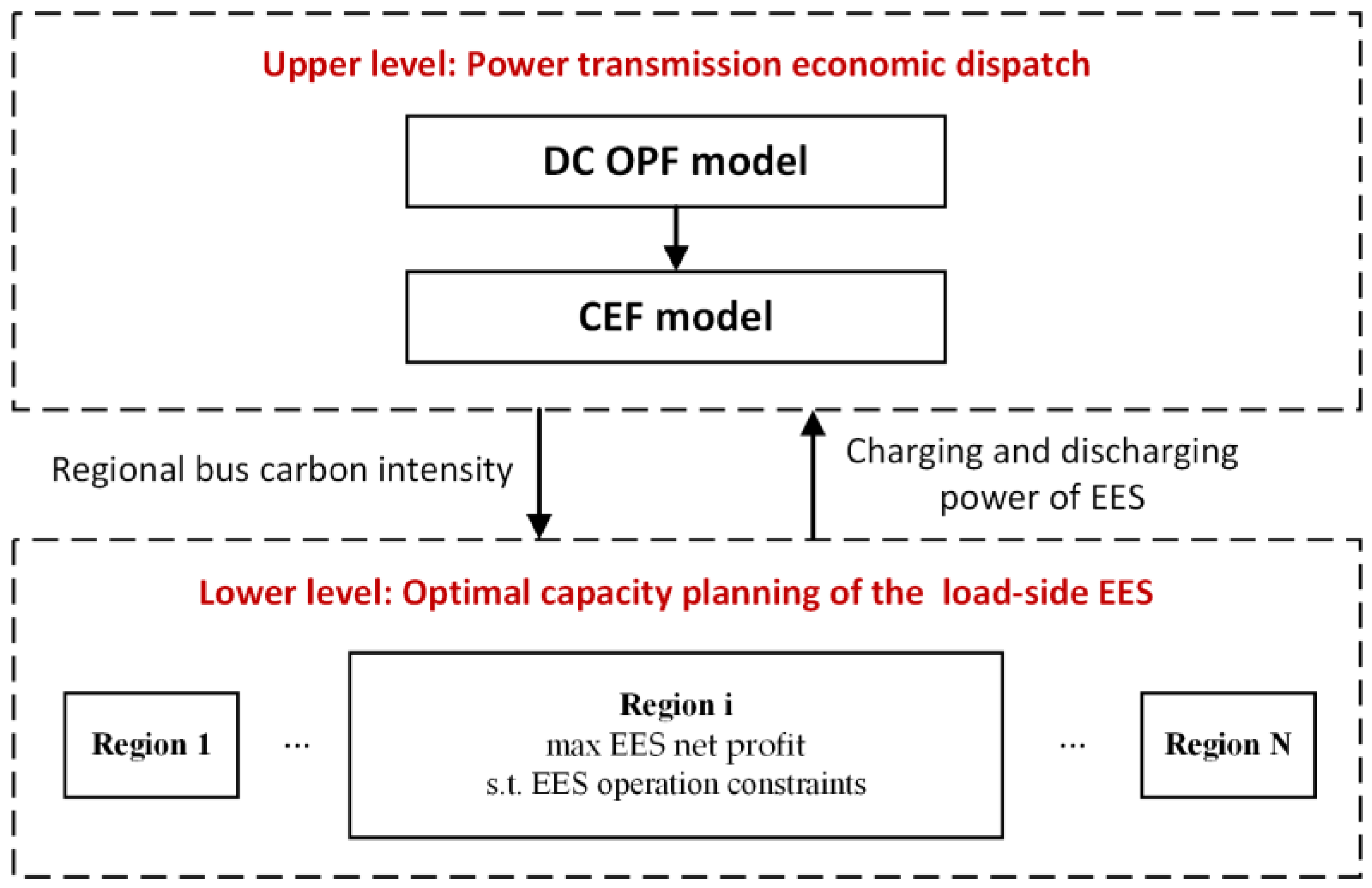
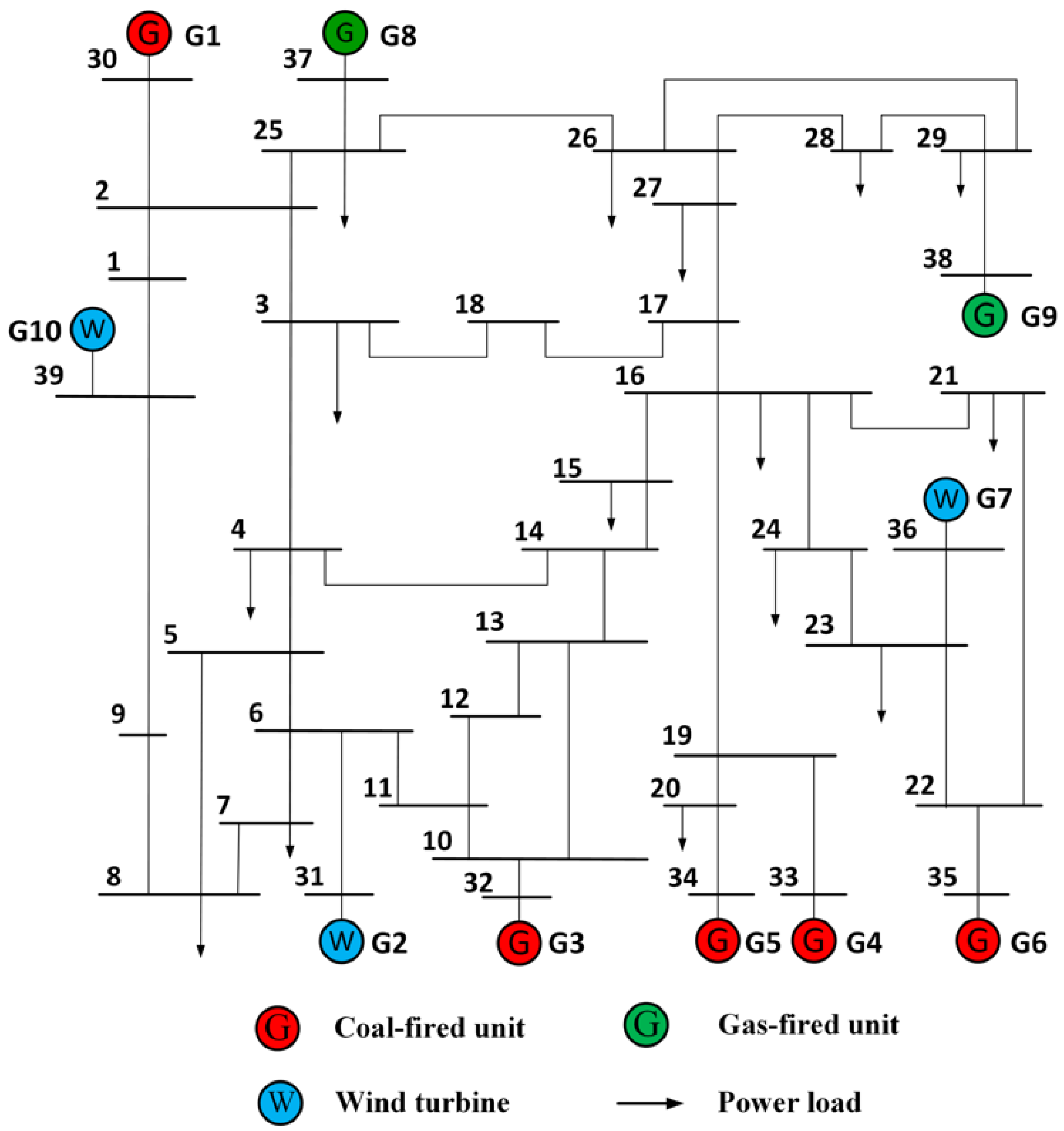
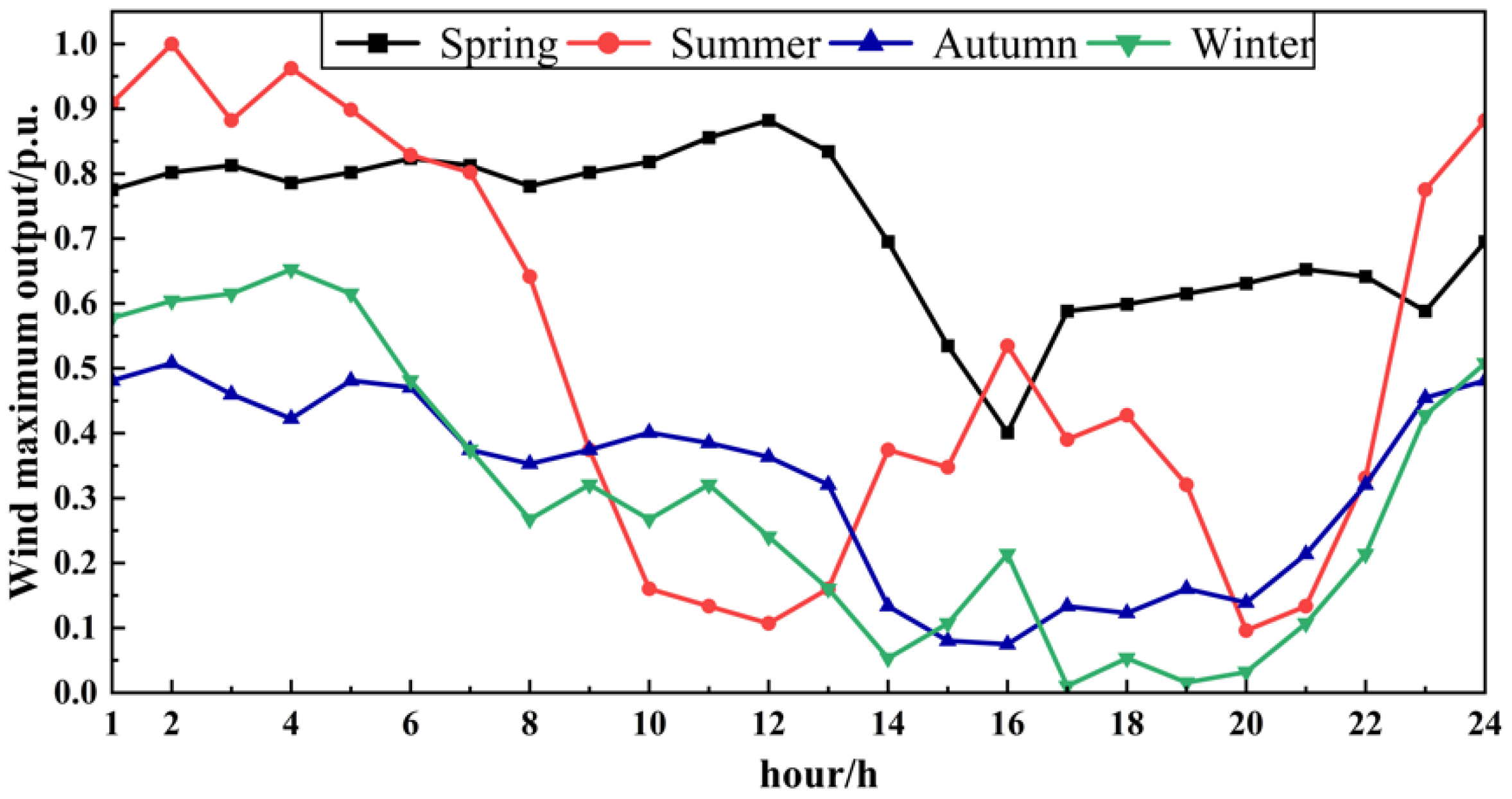
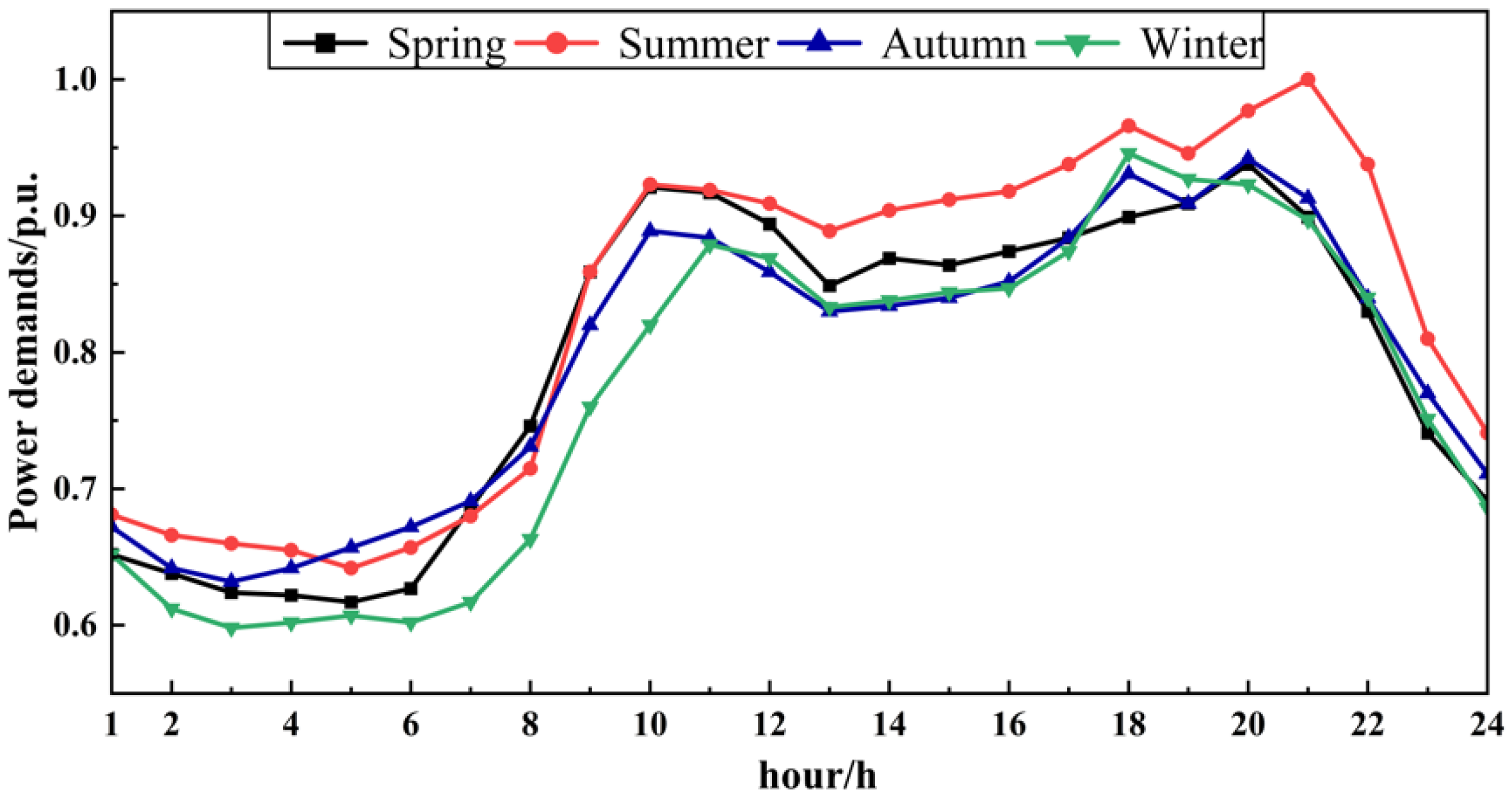

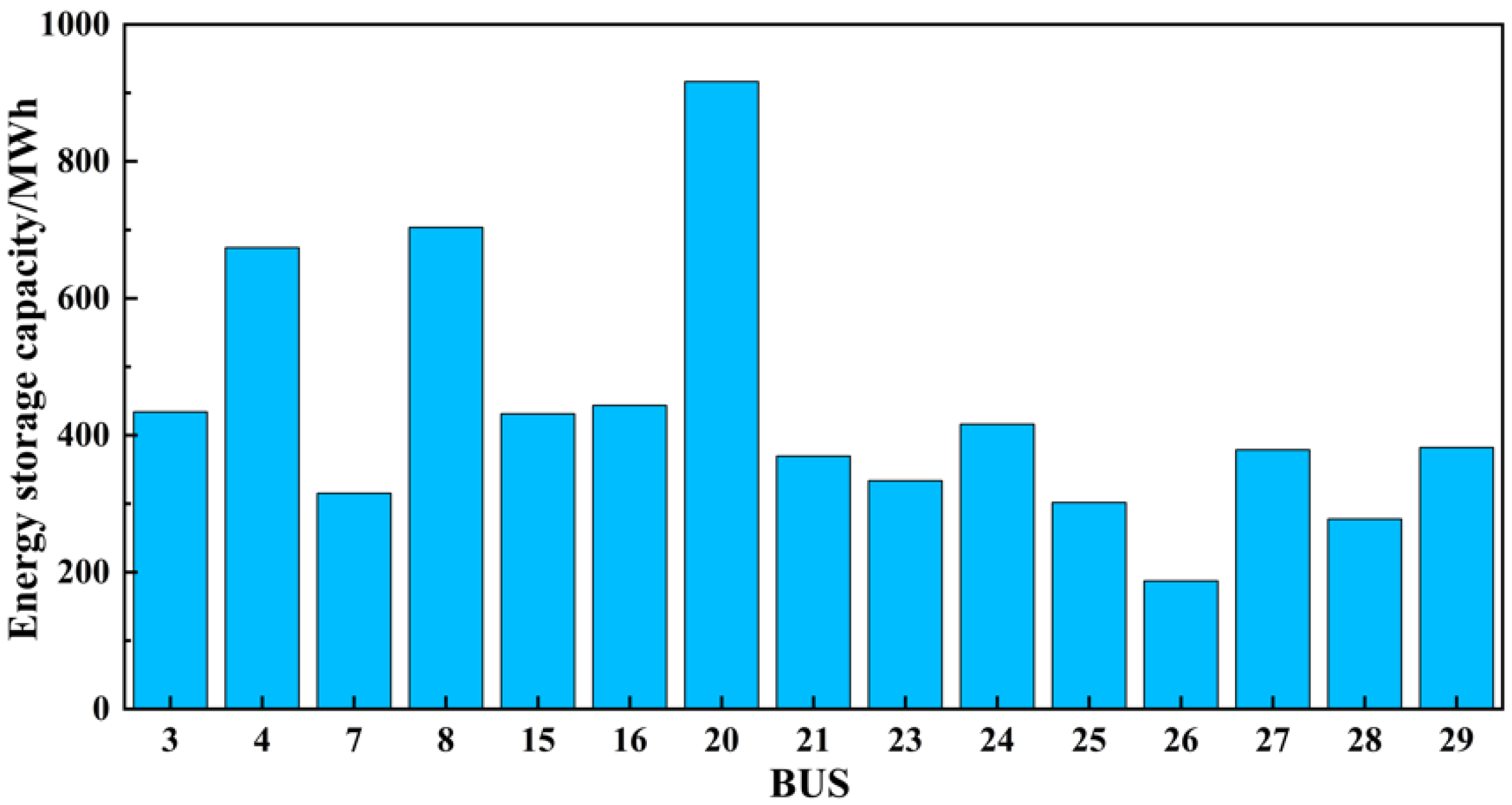
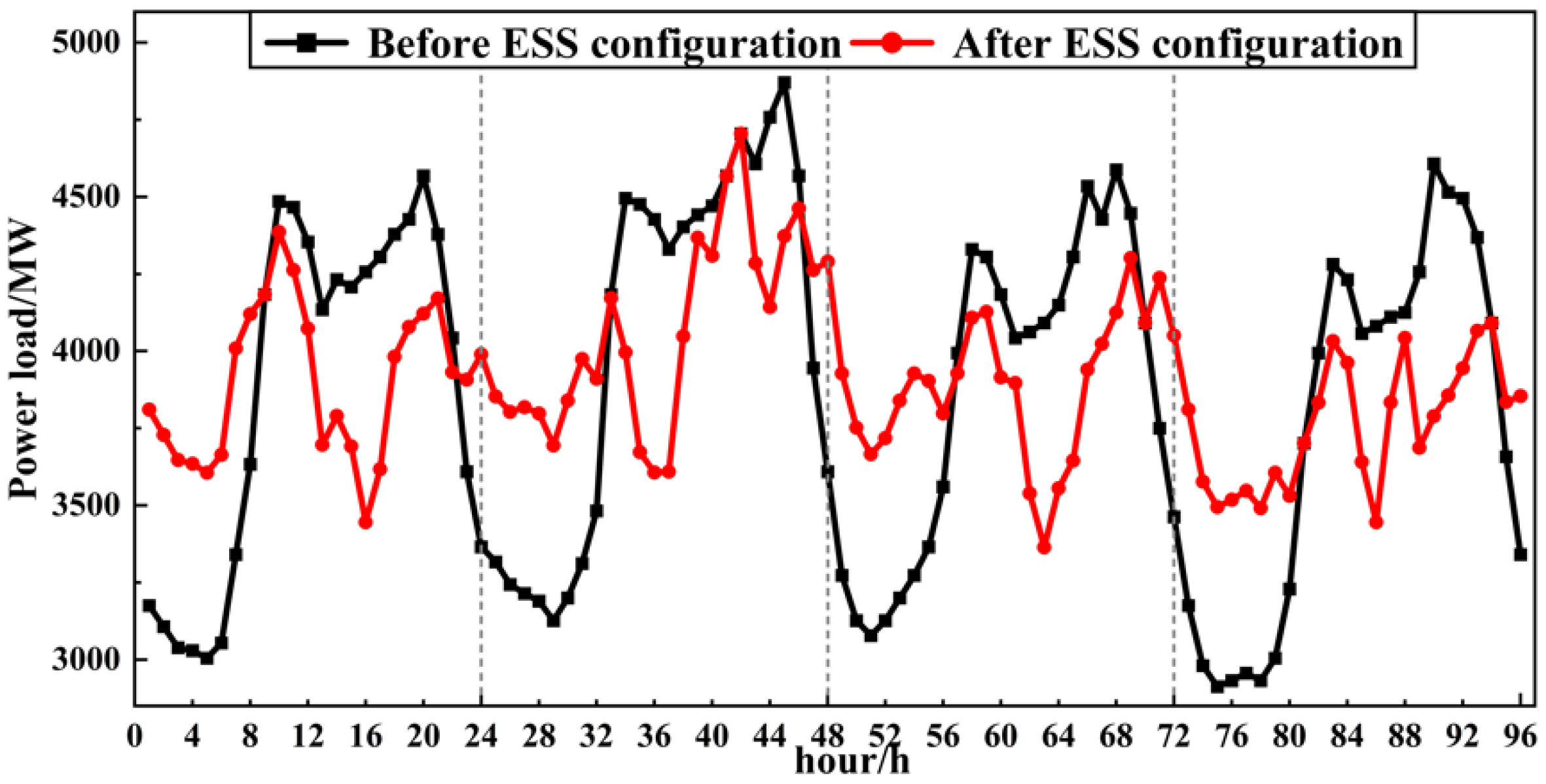

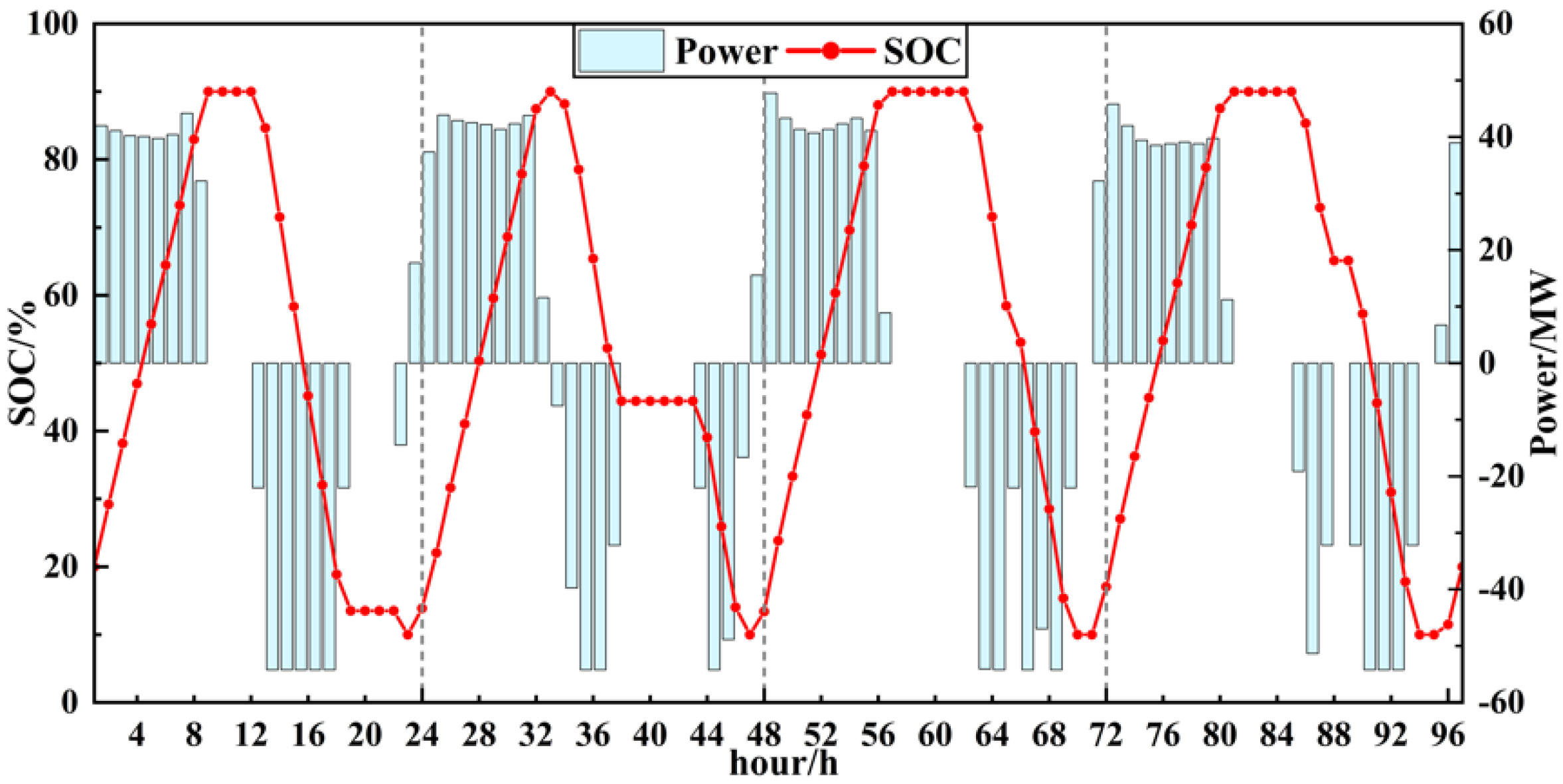
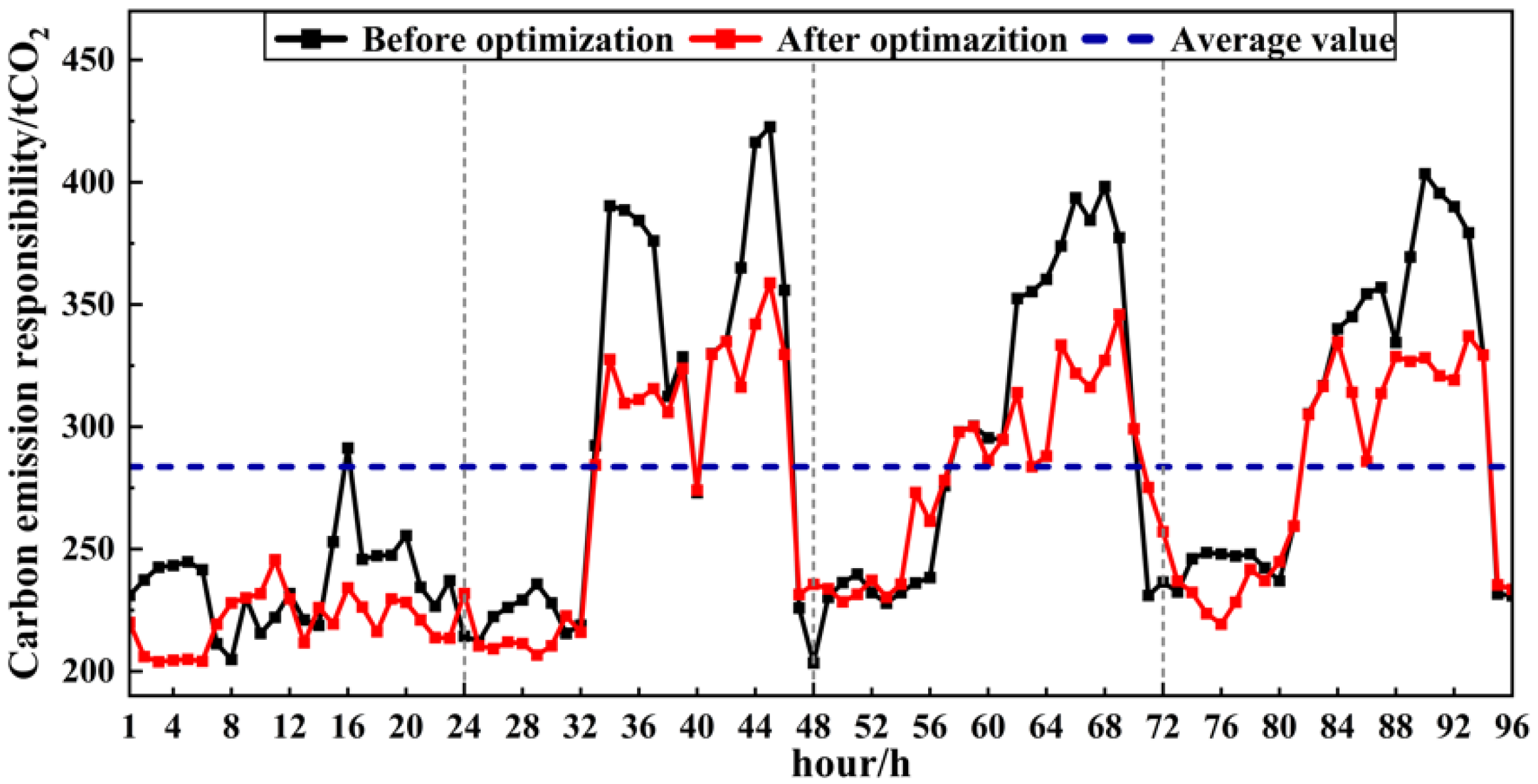
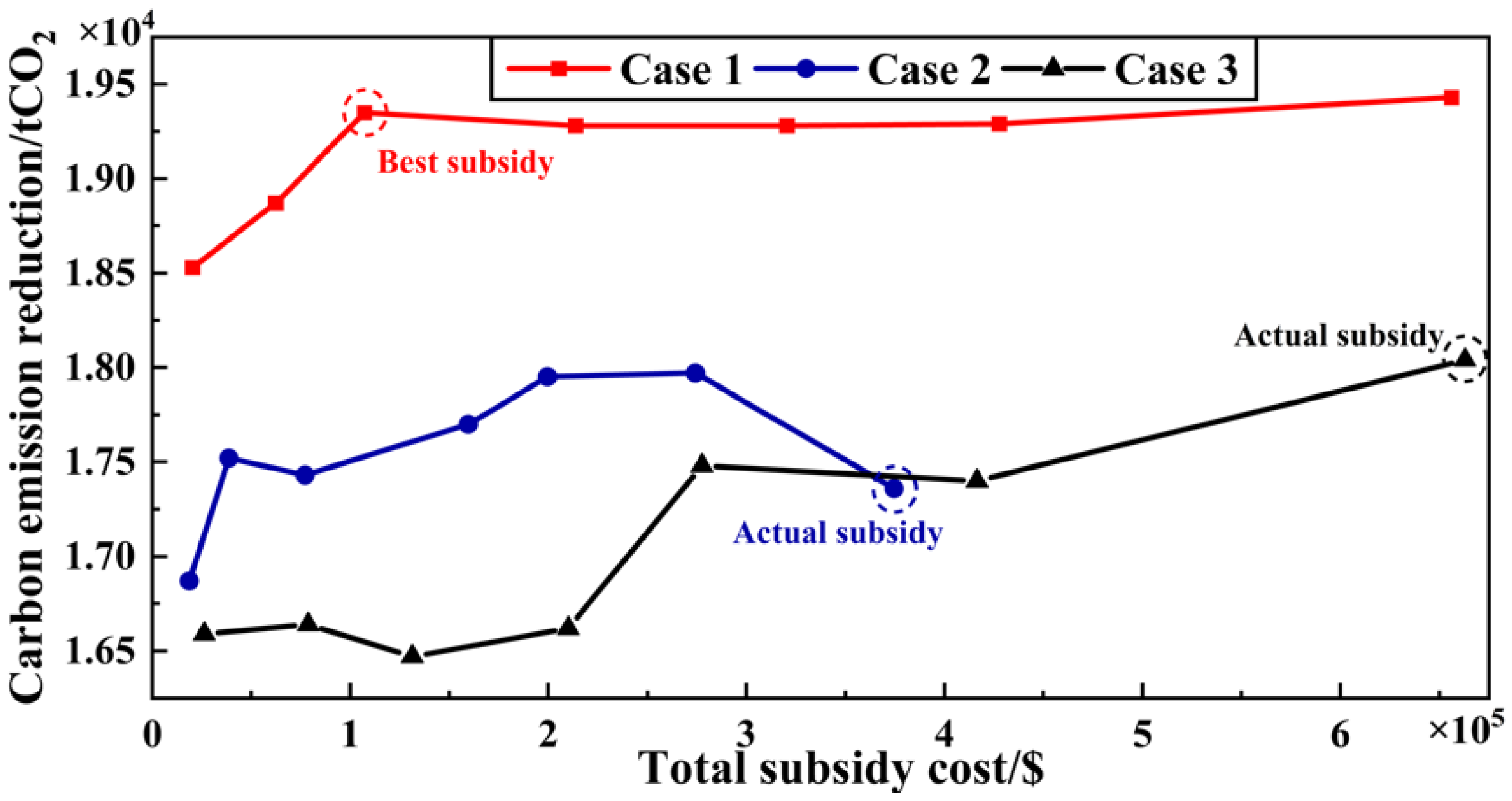
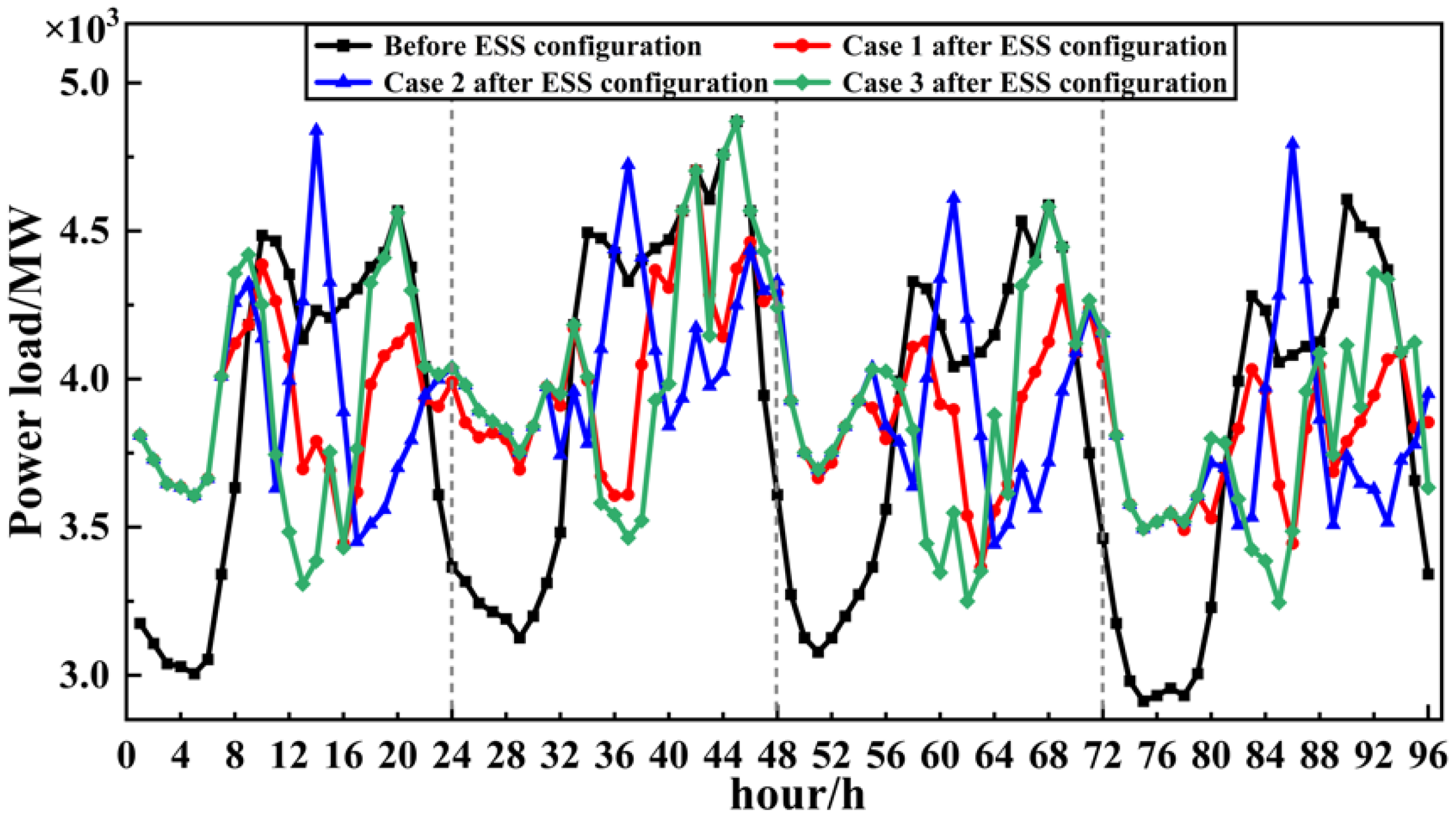
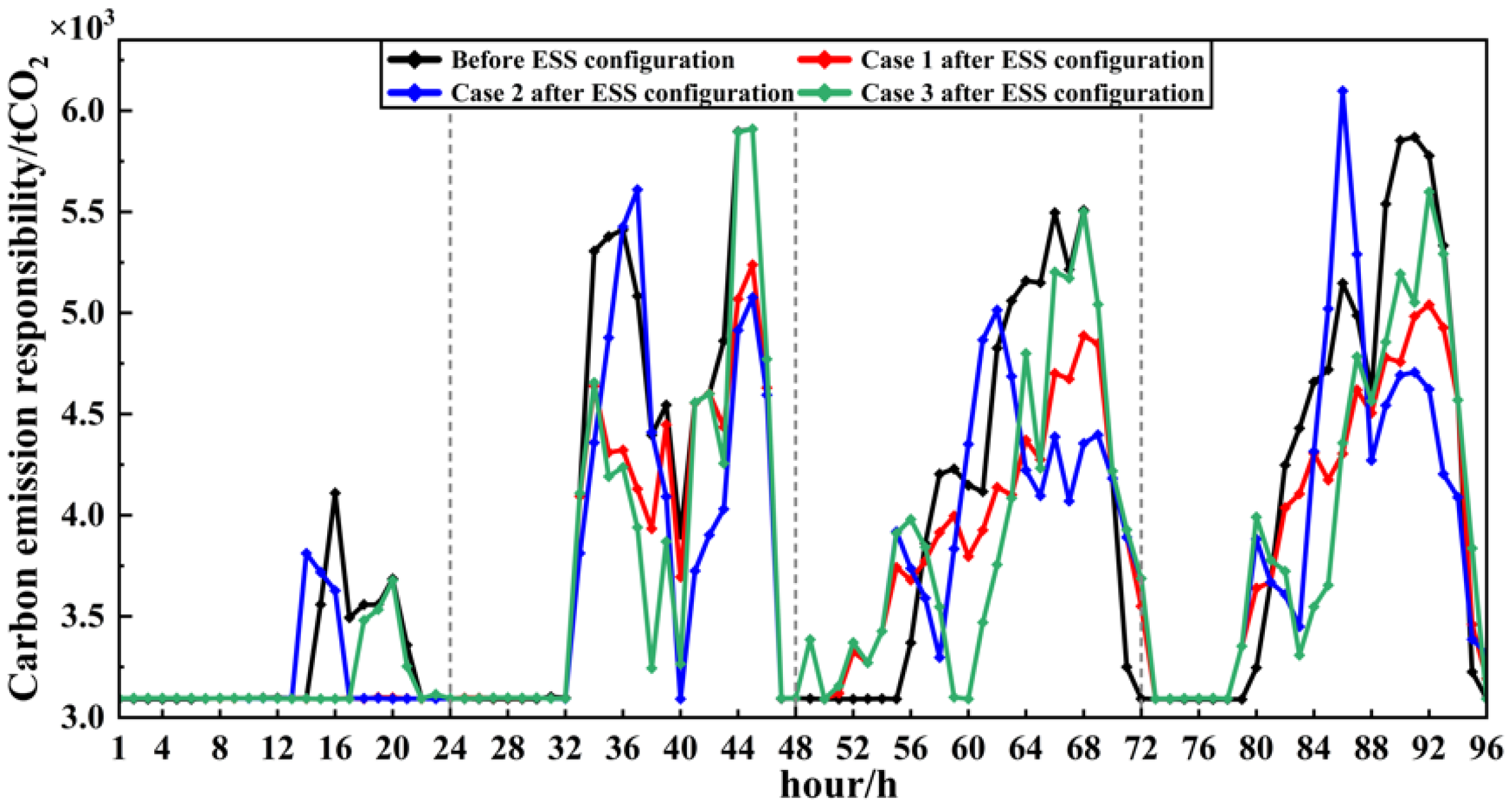
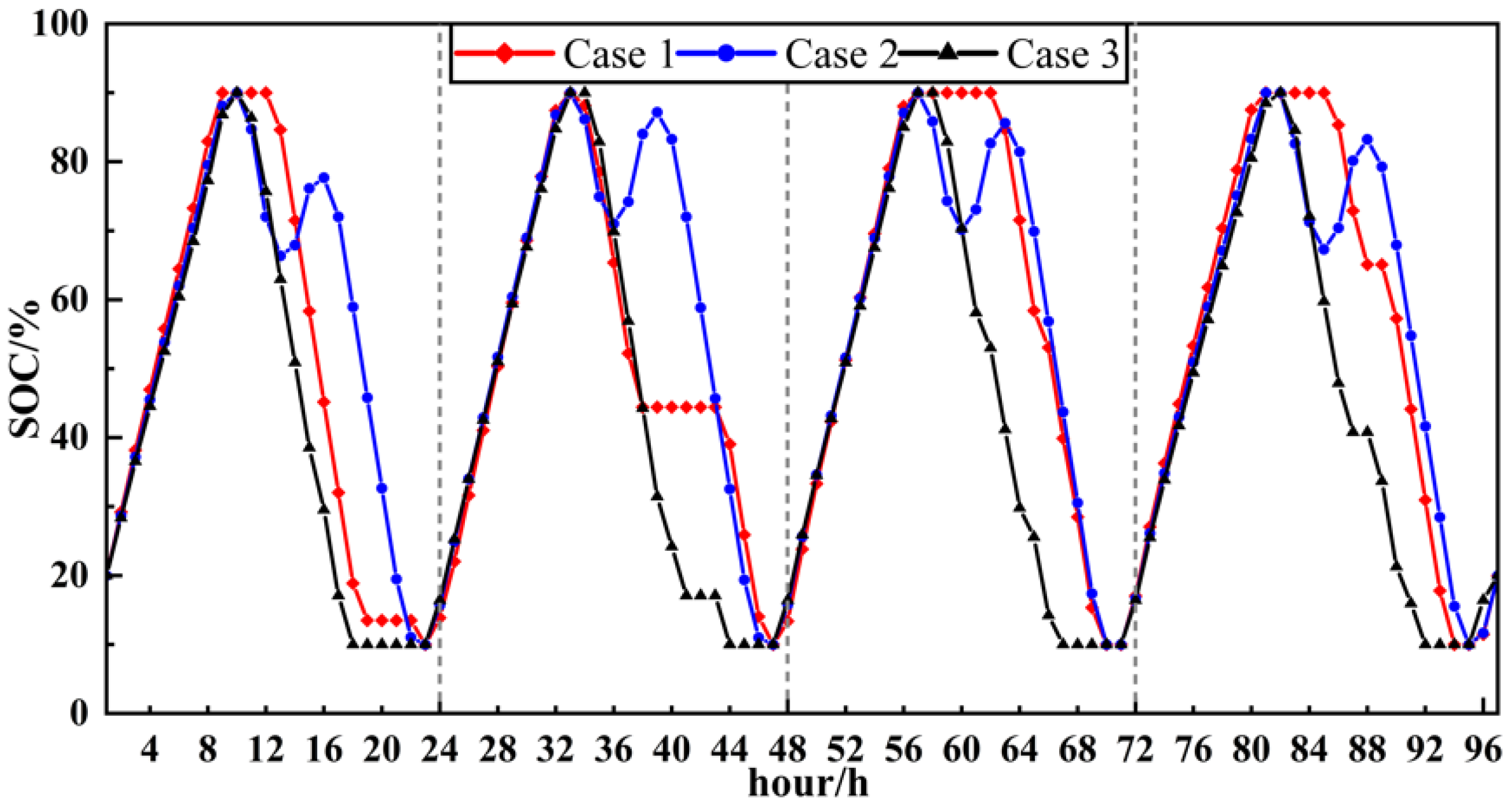
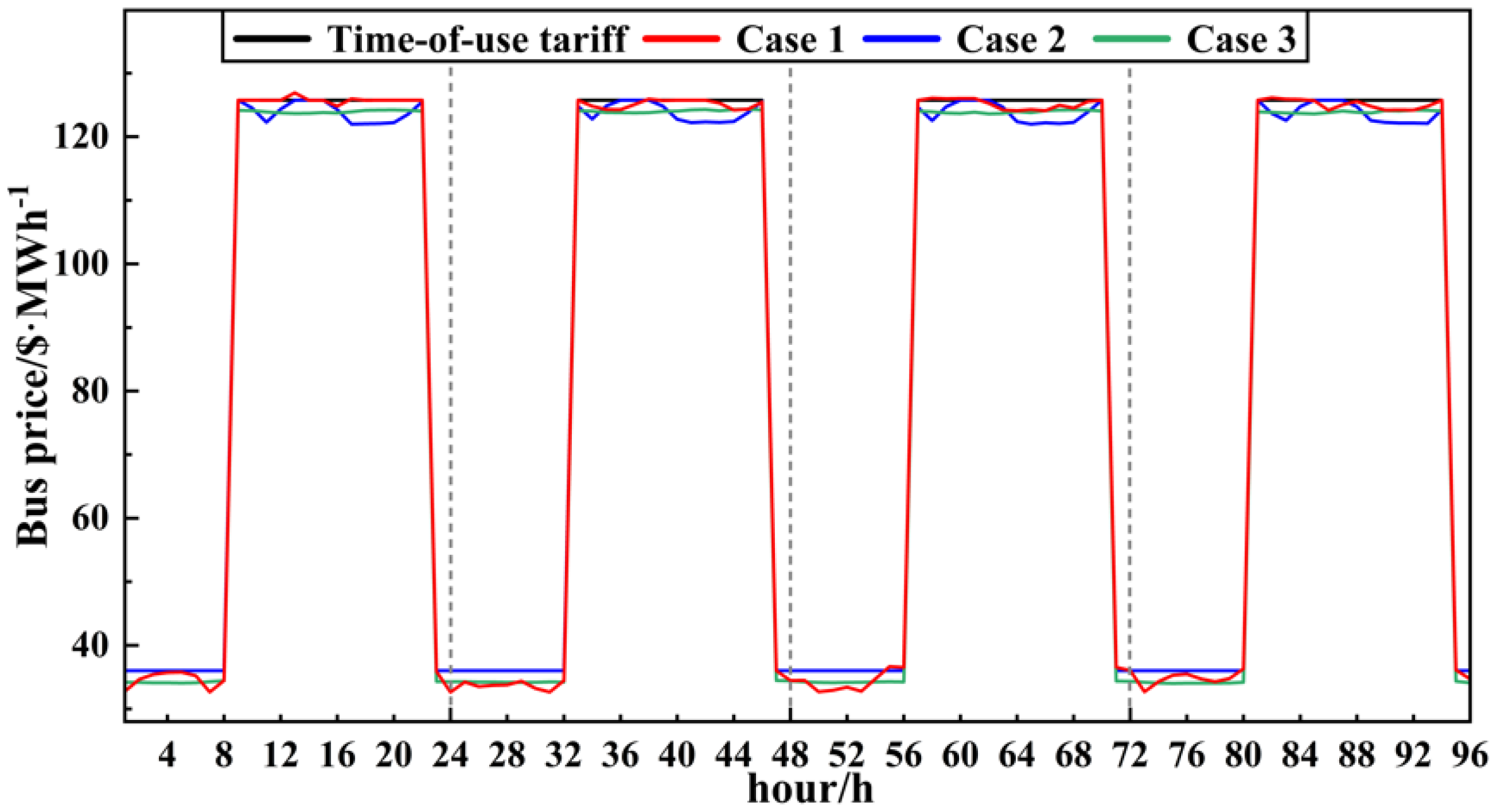
| Unit | Type | Capacity (MW) | Cost Coefficient ($/MWh) | Emission Intensity (tCO2/MWh) |
|---|---|---|---|---|
| G1 | Coal-fired | 1040 | 35 | 1.303 |
| G2 | Wind turbine | 725 | 15 | 0.006 |
| G3 | Coal-fired | 925 | 35 | 1.303 |
| G4 | Coal-fired | 852 | 35 | 1.303 |
| G5 | Coal-fired | 908 | 35 | 1.303 |
| G6 | Coal-fired | 887 | 35 | 1.303 |
| G7 | Wind turbine | 725 | 15 | 0.006 |
| G8 | Gas-fired | 564 | 62 | 0.564 |
| G9 | Gas-fired | 865 | 62 | 0.564 |
| G10 | Wind turbine | 725 | 15 | 0.006 |
| Bus | Power Load (MW) | Bus | Power Load (MW) |
|---|---|---|---|
| 3 | 322 | 23 | 247.5 |
| 4 | 500 | 24 | 308.6 |
| 7 | 233.8 | 25 | 224 |
| 8 | 522 | 26 | 139 |
| 15 | 320 | 27 | 281 |
| 16 | 329 | 28 | 206 |
| 20 | 680 | 29 | 283.5 |
| 21 | 274 | / | / |
| Period | Electricity Price ($/kWh) |
|---|---|
| 0:00~8:00 | 0.036 |
| 8:00~22:00 | 0.126 |
| 22:00~24:00 | 0.036 |
| Period | Coefficient ($/tCO2) |
|---|---|
| period of higher carbon emission responsibility | 5 |
| period of lower carbon emission responsibility | 3 |
| Parameter | Value | Parameter | Value |
|---|---|---|---|
| Unit power cost | 100 $/kW | Charge depth | 90% |
| Unit capacity cost | 250 $/kWh | Discharge depth | 10% |
| Operation cost | 25 $/(kW∙Year) | Recyclable value rate | 10% |
| Service life | 8 Years | Inflation rate | 2% |
| Charge/discharge efficiency | 95% | Discount rate | 10% |
| Case | Energy Supply Cost (107$) | Subsidy (105$) | Capacity Configuration of EES (MWh) |
|---|---|---|---|
| Unsubsidized case | 1.201 | 0 | 0 |
| Proposed method | 1.174 | 1.071 | 6564.9 |
Publisher’s Note: MDPI stays neutral with regard to jurisdictional claims in published maps and institutional affiliations. |
© 2022 by the authors. Licensee MDPI, Basel, Switzerland. This article is an open access article distributed under the terms and conditions of the Creative Commons Attribution (CC BY) license (https://creativecommons.org/licenses/by/4.0/).
Share and Cite
Feng, J.; Zhou, H. Bi-Level Optimal Capacity Planning of Load-Side Electric Energy Storage Using an Emission-Considered Carbon Incentive Mechanism. Energies 2022, 15, 4592. https://doi.org/10.3390/en15134592
Feng J, Zhou H. Bi-Level Optimal Capacity Planning of Load-Side Electric Energy Storage Using an Emission-Considered Carbon Incentive Mechanism. Energies. 2022; 15(13):4592. https://doi.org/10.3390/en15134592
Chicago/Turabian StyleFeng, Jieran, and Hao Zhou. 2022. "Bi-Level Optimal Capacity Planning of Load-Side Electric Energy Storage Using an Emission-Considered Carbon Incentive Mechanism" Energies 15, no. 13: 4592. https://doi.org/10.3390/en15134592
APA StyleFeng, J., & Zhou, H. (2022). Bi-Level Optimal Capacity Planning of Load-Side Electric Energy Storage Using an Emission-Considered Carbon Incentive Mechanism. Energies, 15(13), 4592. https://doi.org/10.3390/en15134592







